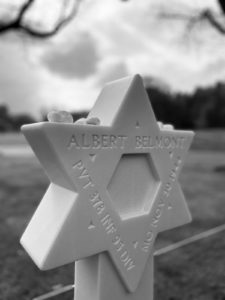
Albert Belmont was one of about 450 Jewish soldiers buried under a cross in World Wars I and II.
His story aligns with many of his Jewish American compatriots who fought overseas, particularly in WWII: When he enlisted, he wrote a “P” by his name instead of an “H,” denoting he was Protestant, not Hebrew.
His eschewed Jewish identity wasn’t from lack of pride; it was a precautionary measure. If he were to be captured by Nazis, his status as a Christian man would spare him being sent to the Berga concentration camp, where many American GIs were prisoners of war.
But for his family, particularly his daughter Barbara Belmont, the Christian cross over Albert Belmont’s head no longer served a purpose. When she took her daughters to her father’s Normandy grave at the Lorraine American Cemetery and Memorial in 1992, Barbara Belmont could only show them the cross he bore above his name on the gravestone. She wanted to show them that their grandfather was a proud Jew.
This April, Belmont, an Alexandria, Virginia, resident, fulfilled that hope, as she watched the cemetery maintenance staff pull the old gravestone at its base and replace it with a granite Star of David, a uniformed U.S. military officer performing a slow salute as she recited the Mourner’s Kaddish.
Belmont didn’t orchestrate the operation by herself — in January, she was contacted by Shalom Lamm, the CEO and co-founder of Operation Benjamin, a nonprofit organization devoted to providing Jewish gravestones for soldiers buried under a cross.
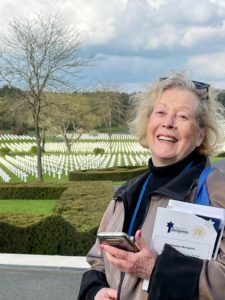
On a three-day trip from April 24-28, Belmont, along with the families of six other dead soldiers, traveled with Operation Benjamin to France, Luxembourg and Belgium, where grave by grave, they honored their loved ones with Jewish gravestones and burial rituals.
For Belmont, the trip allowed her to do something she thought she’d never be able to do: connect with her father, of whom she had no memories.
“It far exceeded my expectations,” she said. “I wanted to feel, standing near my father’s grave and participating in this transition, I wanted to feel that I had touched my father, that I had done something for him. That was really a driving force.”
According to Lamm, that is the crux of Operation Benjamin’s work: “We not only have the soldier, who we’re honoring by getting his story right by identifying him for who he was in life, but we’re doing something with the families as well … You get the sense that you’re making it right; you’re doing something fundamentally right.”
“It Was Just a Curiosity”
Operation Benjamin is relatively young, founded in 2016 by Lamm, Rabbi Jacob J. Schacter and Steve Lamar, largely by coincidence.
“It was an accident,” Lamm said. “It was just a curiosity.”
Schacter, a Jewish historian, was leading a tour of medieval France near Normandy in 2014, when he, on a whim, visited the Normandy American Cemetery. In the sea of crosses, Schacter saw few Jewish stars.
Three months later, when Lamm, a longtime friend of Schacter’s, approached him at a party, Schacter shared his findings but didn’t think much of it. Lamm, a military historian, however, became fixated.
“I ran home that night — it was a Saturday night — and I just was obsessed with this idea,” he said. “I don’t know why, but I was obsessed with this idea that something was wrong.”
Lamm counted 149 Jewish stars at the cemetery but calculated a discrepancy: “There are about 9,500 U.S. GIs buried in Normandy, and Jews are about 2.7% of the casualties.”
Instead of 149 Jews buried at the military cemetery, there should have been, statistically, closer to 250.
Lamm and his colleagues experimented. They picked a random, Jewish-sounding name of a soldier buried under a cross — Pvt. Benjamin Garadetsky — and did extensive research, only to find out the soldier was “fully Jewish.”
“His family was from Zhytomyr [Ukraine], and they settled in the Bronx in the early 1900s,” Lamm said. “And his parents were buried about 10 minutes from my house in Long Island. It was the craziest coincidence.”
Garadetsky became the first soldier to have his grave marker changed by Operation Benjamin. So far, the organization has changed 16 headstones, with three more pending, over five trips.
The process of finding Jewish soldiers is complicated. Operation Benjamin, in collaboration with the American Battle Monuments Commission and a team of genealogists, spends months looking for documents that confirm an individual as Jewish: bar mitzvah or wedding photos, U.S. Census documents, connections to a rabbi or papers in Yiddish. Many times, a soldier would have been too young to get married. Instead, Operation Benjamin would search for materials from a relative.
“At the end of the day, we’re trying to prove that somebody was born a Jew, lived as a Jew and they fought as a Jew,” Lamar said.
Before ABMC can complete the paperwork for a gravestone marker change, however, a family member must provide consent. Finding a relative — sometimes a distant one if the soldier had no wife or children — takes time.
Lamm has to almost instantaneously convince the person on the other end of a phone call or email — who may not even know about their deceased relative — that he isn’t a solicitor or spammer.
“We’ve had to figure out how to gain people’s trust on the first email, and we worked very hard on that,” Lamm said.
When Lamm reached out to Belmont, she was happy to pick up the phone and talk.
“I Have No Memories of My Father”
Barbara Belmont was only 3 when her father died.
The Belmont family was in the photography business in Kansas City, and Albert Belmont was a young Jewish philanthropist.
He enlisted at age 32, and despite coming from a wealthy family, Albert Belmont insisted on receiving no preferential treatment.
“He wanted to be just one of the soldiers,” Barbara Belmont said.
Albert Belmont arrived in France on Nov. 1, 1944, as part of a division of reinforcements to Gen. George Smith Patton. He spent the month traversing the country to its northeastern region by Metz, where the German forces had doubled down on forces and artillery. He was killed on Nov. 30, just two weeks before the Battle of the Bulge.
The Belmont family received a telegram on Dec. 11 informing them of Albert Belmont’s death. Belmont had just turned 3, and her sister was 7.
“I have no memories of my father. It was a very difficult time,” Belmont said.
Belmont, whose mother remarried, was adopted by her stepfather. Though she knew her stepfather was not her biological father, Belmont only started to gain a connection with her father a decade after his death.
When Belmont was 13, her sister pulled her into her bedroom and shut the door, taking out a picture frame and revealing a picture of their father hidden behind another photograph.
“That was the first time I’d ever seen him or had any idea what he looked like,” she said.
In 1992, when Belmont took her daughters to her father’s grave for the first time, something felt like it was missing.
“We visited his grave … I don’t know what I expected,” Belmont said. “I felt I had done something, but it wasn’t nearly enough.”
In the 30 years since Belmont visited her father’s grave, she had gotten in touch with various cousins and learned more about Albert Belmont. As Belmont spent time over her life putting together the pieces of her father’s life and her relationship with him, the connection was still not seamless. Life changes prevented Belmont from prioritizing ways to honor her father.
“Life happens,” Belmont said. “But he was never out of my mind.”
“They Never Had a Kaddish Said”
Just like in 1992, Belmont brought daughters Erin McCahill and Jennifer Soloway with her on the trip to her father’s grave in April.
The family was accompanied by 15 other family members, as well as a whole host of ambassadors, veterans and military officers there to pay their respects to the soldiers.
On an overcast day with the sun only occasionally peeking through the clouds, Belmont and her daughters said the Mourner’s Kaddish for each of the graves they had passed, for soldiers who had never had a Kaddish said for them, Belmont said.
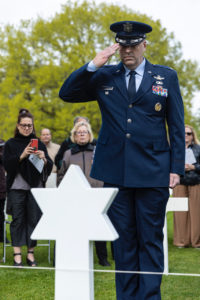
Colonels and lieutenant colonels did slow salutes as the gravestones were changed, an act of respect often done during retirements, and a rarity for officers with seniority to do for privates and soldiers of lower rank.
As Belmont’s family approached Albert Belmont’s grave, where they and dozens of guests paid their respects, Barbara Belmont noticed something she hadn’t seen her daughter do in years: cry.
“She was so amazed of the emotions that started to erupt inside of her about this grandfather she didn’t know,” Belmont said.
The trip changed the dynamic of Belmont’s family, she said.
“I’ve never seen us so tight. I mean, I couldn’t turn around and I didn’t have one of them on one side or the other,” she said. “But I could not have done anything more wonderful for our family than this.”
“Our Goal is To Go Out of Business”
Operation Benjamin recognizes its work is finite, Lamm insists. Though at the rate they’re going at (about 25 graves a year), Lamm will be more than 400 years old by the time all the gravestones are replaced.
“Our goal is to go out of business,” he said. “Our goal is to shut the lights and quietly fade into the darkness.”
Lamm said Operation Benjamin is not an education center or Jewish genealogy specialist. The organization serves a specific purpose, which Lamm’s co-founder Lamar believes has a more profound impact on the participating families.
“We’re not just righting historical wrongs,” Lamar said. “We are refreshing the memories of the soldiers.”
This was the case for Dr. Ira La Voe, a Philadelphia-based physician, who, through Operation Benjamin, found out that his grandmother’s youngest brother died in Manila, Philippines during WWII.
La Voe would likely have never met his great-uncle, but the experience made him think about his family connections: his childhood home, memories with his grandparents, aunts and uncles of generations past that he hadn’t stopped to think about for a while.
“We just came full circle … doing the right thing for a generation that was forgotten for many of us because we just didn’t have a connection,” he said.



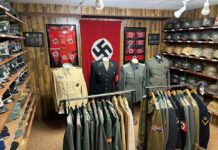
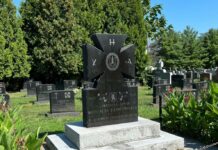
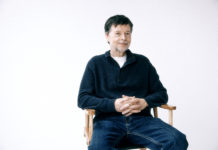

I am a veteran, and the son of a veteran .Regarding operation Benjamin,I visited the shores of the invasion of Normandy,France where our WW II patriotic heroes who never came home ,the fallen,are buried.I made it a point to put a stone of remembrance on every Jewish star david monument that I saw.
J k lipner,miami